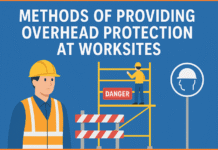A workplace health and safety committees (HSC) is a formal committee established to facilitate cooperation between an employer and workers in developing and carrying out measures to ensure health and safety at work. It is one of the methods of consultation.
Contents
Types of health and safety committee:
- Central safety committee
- Plant safety committee
- Department safety committee
- Foreman safety committee
There shall be equal representation of management and employee representation in the safety committee.
The objective of the health and safety committee
- Study of accident and disease statistics to recommend remedial actions.
- Review of new legislation and guidance and their effects
- Monitor and review of OHS training and instruction activities
- Examine audits and statutory inspection reports of OHS.
Training:
Training can be defined as the imparting of skills and knowledge in a structured manner in a relatively safe Environment.
The effect of training:
Training is an important aspect of building the competency of the workers. It improves his knowledge and changes their attitude towards health and safety. It also acts as a motivating factor to work safely and improves the worker’s perception of risks.
Once the workers are properly trained:
- They develop their awareness and understanding of the specific hazards and risks associated with their jobs and working environment.
- It will communicate from hazards and them of the control measures that are in place and any related safe work procedures that must be followed.
- The emergencies that can happen and the action that needs to be taken.
- Several benefits will gain to the employer by the information and training to employees.
Benefits to the Employer:
- Increased productivity
- Decreased Accidents
- Happy workforce
- Better reputation
- Business profitability
Training opportunities:
The following could be the opportunities when training needs to be imparted to workers.
- Induction training: this is given to employees who have joined the organization and before they can settle down with their daily routine the organization needs to give them safety induction to make them aware of the companies rules and procedures and site-specific information.
- Job change: when a workers job profile changes. Like if an office worker has been given the task of visiting customers at their site, then lone workers training, training in safe road travel etc. May have to give.
- Process change: A change in the way of doing things may expose the workers to additional hazards, this need to be communicated by training.
- New technology: The introduction of new technology bring with it many benefits but also add to the hazards already existing. For e.g. the introduction of hand-held bar code scanners in a shopping mall should be done by training the workers concerned about the hazards of lasers.
- New legislation: New laws been passed by the national governments may require training to be given to the workers, so as to understand its implications on their routine activities.
- Training may also be required to give after a risk assessment is made or revised; after an accident investigation, to prevent a recurrence; after an audit or a notice by enforcement agency etc.
The content of general induction training to new workers
- companies’ health and safety policy- targets
- Fire & other emergency procedures- Assembly point
- Location of welfare facilities
- Safe movement around the workplace
- Incident reporting procedure
- Workers consultation arrangements
- General safety rules and employee code of practice
- Personal protective equipment-requirement and use
- Introduction to risk assessment-JSA controls
- Introduction to SSW & PTW etc.
- Co-operation and co-ordination
- Do’s & Don’t- Drug abuse-Disciplinary procedures
Training Needs Analysis:
Each worker would require a different set of skills and capabilities and hence the training that needs to be imparted needs to be properly evaluated and planned. To do this the organization needs to carry out a training needs analysis in which the following factors can be considered:
- The hazards present in the work carried out.
- Statutory training as required by the law. For e.g. firefighting, first aid, emergencies.
- The level of competence already existing and further training that needs to be given to close the gap incompetency.
- The accident history of the organization.
- Presence of a vulnerable group.
Training Records:
Once the training has been provided it becomes important that proper records are maintained. Training records help us in the following way:
- It helps us track the progress in training with respect to the training plans.
- Helps in evaluating the effectiveness of training
- It helps in determining the competence level of a worker.
- It let us know when refresher training is to be planned.
- In case of an accident or an audit by a regulator, it helps in proving that adequate training has been provided.
Evaluating the Effectiveness of training:
Ultimately for a training to be successful, it needs to be effectiveness. Post training, the trainee and his superior may meet regularly during appraisal and check of the training imparted as had any changes in the way the trainee is working. Following are some are the indicators that the training has been effective:
- A decrease in accident severity and frequency;
- A decrease in injury and ill-health related condition;
- A decrease in compensation claims and, possibly, insurance premiums;
- An improvement in the health & safety culture of the companies.
- Improvement of employer morale and retention.
- Improvement in safe systems of work.
Safety Committee meeting minutes Sample
Also read this:
OIL AND GAS SAFETY OFFICER INTERVIEW QUESTIONS






Sir, safety officer latest job update, send kijiye🙏🙏 please
Please send worker welfare facilities like (toilet,rest room, centeen availability) at construction side on my mail
Lakhansinghsafety@gmail.com
hi sir
Hi there
Send me safety interview questions
Safe work safe environment.